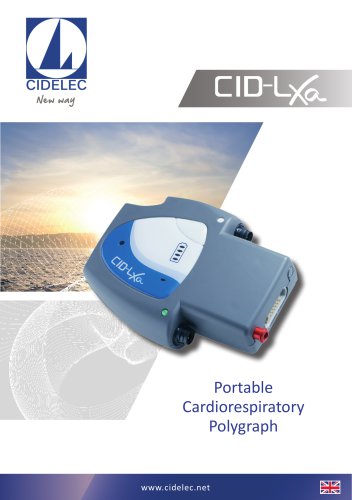
Catalog excerpts

Tous les hommes vivent dans le même monde lorsqu'ils sont éveillés, mais dans un monde qui leur est propre lorsqu'ils sont endormis. Plutarque All men whilst they are awake are in one common world; but each of them, when he is asleep, is in a world of his own. Plutarch
Open the catalog to page 2
Establishing a proper sleep diagnostic may be a challenge for a sleep specialist. With a high prevalence within the population and a strong impact on numerous aspects of the patient's health, and still many yet to be discovered, sleep disorders proper diagnostic requires a fair amount of transversal knowledge. This is the reason why CIDELEC has been designing and manufacturing polygraphy and polysomnography systems for more than 25 years, thus allowing the company to have a wide knowledge and experience with best practices for this particular type of diagnosis. Polygraphy and...
Open the catalog to page 4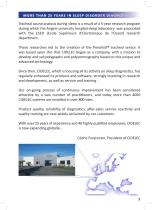
Tracheal sound analysis during sleep is a result of a 5-year research program during which the Angers university hospital sleep laboratory was associated with the ESEO (Ecole Supérieure d'Electronique de l'Ouest) research department. These researches led to the creation of the PneaVoX® tracheal sensor. It was based upon this that CIDELEC began as a company, with a mission to develop and sell polygraphs and polysomnographs based on this unique and advanced technology. Since then, CIDELEC, which is focusing all its activity on sleep diagnostics, has regularly enhanced its products and...
Open the catalog to page 5
P R O D U C T S P R E S E N TAT I O N CIDELEC designs, manufactures and markets a complete range of systems helping in diagnosis of pathologies related or aggravated by sleep. All our systems use the same CIDELEC software. CID-LX and CID-LX-206d: Portable polygraphs The CID-LX portable polygraph comes along with our exclusive PNEAVOX® tracheal sound sensor technology, pressure sensor for nasal cannula, oximetry channel, built-in actimetry, and light detection. Placed on the wrist, this lightweight unit gives a higher comfort for the patient. Once programmed the machine follows the patient...
Open the catalog to page 6
CID-LXe and CID-LXe-206d: portable polysomnographs with 8 electrophysiological channels The CID-LXe is a type II portable polysomnograph. Thanks to its design including all necessary respiratory channels as well as 8 electrophysiological channels, it will be able to perform a complete sleep recording. Coming with our PNEAVOX® sensor technology, the analysis of respiratory disorders is reliable, accurate and correlated with the patient's sleep. Small and autonomous, the CID-LXe is equipped with an internal Li-Po battery and memory for a 10 hours recording. The CID-LXe provides an advanced...
Open the catalog to page 7
Analysis software Bluetooth connection Ethernet connection Network (Wi-Fi or Ethernet) The signals are collected by the CID-LXr and displayed in real time on the TrackBoX touchscreen. Both devices can communicate wirelessly. TrackBoX-Live, the remote visualization tool that is installed on the control room computer allows medical staff to monitor the recording process during the night. The CIDELEC software The CIDELEC software is compatible with all our devices. It has been developped to analyse the files generated by all our devices. Simply connect the system to the computer and access all...
Open the catalog to page 8
Quick Guide to Sleep Diagnosis - QGP-EN-9
Open the catalog to page 10
The PneaVoX® technology is unique, it enables the recording of 3 physiological parameters with just one sensor : • Breathing in upper airways (both buccal/oral and nasal) • Respiratory efforts in order to differentiate apneas types : central, obstructive and mixed • Snoring In addition, the PneaVoX® sensor provides an estimation of upper airways resistance by measuring their inner acoustic intensity. 12 Quick Guide to Sleep Diagnosis - QGP-EN-9
Open the catalog to page 12
T 1 he PNEAVOX® tracheal sensor is applied on the throat skin, creating a closed acoustic chamber. 2 The pressure and the sound are measured inside the chamber, giving a raw signal. 3 pplied frequency filtration splits sounds emitted during breathing with snoring A and pressure variation giving 3 different signals (correlated to breathing efforts). After filtration, signal intensities are analyzed, thus providing the following data: 4 reathing intensity and inspiration/expiration, displayed as Sound 1 and B Intensity 1 for apnea detection. 5 Snoring Detection, displayed as Sound 2 and...
Open the catalog to page 13
Breathing Sound The Breathing Sound curve provides an acoustically measured representation of breathing and snoring. Ei/Ee Ei/Ee is the ratio of Inspiratory Energy over Expiratory Energy. Based on acoustic measures, it shows upper airways resistance changes. Resistance increase during inspiration is represented in red (Ei > Ee). Resistance increase during expiration is represented in blue (Ee > Ei). Upper airways resistance increase Arousal suspicion Figure showing a resistance increase of the upper airways (Ei/Ee in red), interrupted by a micro-arousal (seen on the EEG signal). After the...
Open the catalog to page 14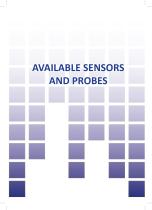
AVAILABLE SENSORS AND PROBES
Open the catalog to page 15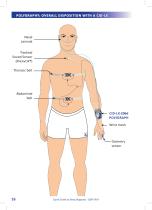
POLYGRAPHY: OVERALL DISPOSITION WITH A CID-LX Nasal cannula Tracheal Sound Sensor (PNEAVOX®) Thoracic belt Abdominal belt CID-LX-206d POLYGRAPH Wrist mesh Quick Guide to Sleep Diagnosis - QGP-EN-9
Open the catalog to page 16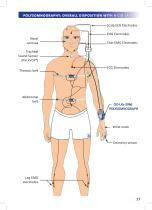
POLYSOMNOGRAPHY: OVERALL DISPOSITION WITH A CID-LXe Scalp EEG Electrodes EOG Electrodes Nasal cannula Tracheal Sound Sensor (PNEAVOX®) Thoracic belt Abdominal belt Wrist mesh Oximetry sensor
Open the catalog to page 17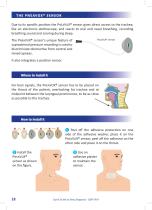
T H E P N E AV O X ® S E N S O R Due to its specific position the PNEAVOX® sensor gives direct access to the trachea, like an electronic stethoscope, and reacts to oral and nasal breathing, recording breathing sound and snoring during sleep. The PNEAVOX® sensor's unique feature of suprasternal pressure recording is used to discriminate obstructive from central and mixed apneas. PNEAVOX® sensor It also integrates a position sensor. Where to install it For best signals, the PNEAVOX® sensor has to be placed on the throat of the patient, overlooking his trachea and at midpoint between the...
Open the catalog to page 18

